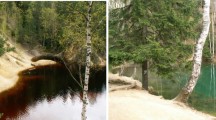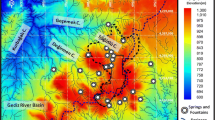Abstract
The dewatering system of the Lipovsky nickel mining pit (Middle Urals, Russia) has performed a dual role. From 1961 to 1991, while nickel was being mined there, it protected the pit from flooding with groundwater; since 1989, it has been the principal source of drinking water for the town of Rezh (≈ 50,000 residents). After mining ceased, water withdrawal from the drainage wells decreased 2.5 times (to 100 L/s), resulting in a 120 m deep pit lake. A mass balance analysis has shown that water from the pit lake has become the leading source of water intake. However, the concentrations of the water’s basic constituents at the eastern edge of the pit are several times higher than at the western edge. The reason for the significant increase in the water withdrawn by the wells of the western intake is the fact, that during the working of the main ore body, the eastern part of the pit was filled with overburden rock and substandard ore with dispersed sulfide mineralization. Flooding of the pit created a single aquifer between the pit lake and the eastern water intake facility, including an artificial aquifer within the refilled part of the pit. The rise of the groundwater level in the artificial aquifer to an elevation above 150 m (after 1994) led to active chemical weathering of sulfide-containing minerals and dissolution of secondary sulfates, which accounts for the increasing levels of constituents in the eastern part of the pit. The artificial aquifer has become a generator of salts. The dumping of sulfidic wastes and subsequent recovery of the water table have led to the release of sulfate, calcium, and metals into the local groundwater. To prevent the formation of an artificial aquifer, it is necessary to either completely remediate the unflooded portion using non-acid generating material or completely inundate the pit. Partial remediation would be the worst scenario as it could destabilize the hydrogeochemical processes and render long-term coexistence of the drinking water intake and the flooded pit problematic.
Zusammenfassung
Das Entwässerungssystem der Nickelgrube Lipovsky (Mittlerer Ural, Russland) hat eine doppelte Rolle gespielt. Von 1961 bis 1991, als dort Nickel abgebaut wurde, schützte es die Grube vor einer Flutung durch Grundwasser. Seit 1989 stellt es die Hauptförderquelle für Trinkwasser der Stadt Rezh (ca. 50.000 Einwohner) dar. Nach Beendigung des Bergbaus verringerte sich die Wasserentnahme aus den Entwässerungsbrunnen um Faktor 2,5 (auf 100 L/s), was zur Entstehung eines 120 m tiefen Grubensees führte. Eine Massenbilanzanalyse hat gezeigt, dass Wasser aus dem Grubensee zur Hauptquelle für die Wasserentnahme geworden ist. Die Konzentrationen der Hauptbestandteile des Wassers am östlichen Rand der Grube sind jedoch um ein Vielfaches höher als am westlichen Rand. Der Grund für die signifikante Zunahme der Wassermenge, die durch die Brunnen an der westlichen Entnahmeseite entnommen wird, ist die Tatsache, dass während der Bearbeitung des Haupterzkörpers der östliche Teil der Grube mit Abraumgestein und minderwertigem Erz mit dispergierter Sulfidmineralisation gefüllt wurde.
Die Flutung der Grube schuf einen einzigen Grundwasserleiter zwischen dem Grubensee und der östlichen Wasserentnahmeanlage, sowie einen künstlichen Grundwasserleiter im rückverfüllten Teil der Grube. Der Anstieg des Grundwasserspiegels im künstlichen Grundwasserleiter auf eine Höhe über 150 m (nach 1994) aktivierte die chemische Verwitterung sulfidhaltiger Mineralien und die Auflösung von Sekundärsulfaten, was zu steigenden Konzentrationen an Wasserinhaltsstoffen im östlichen Teil der Grube führte. Der künstliche Grundwasserleiter wurde zu einem Salzgenerator. Das Einbringen von sulfidhaltigen Abfällen und der anschließende Anstieg des Seewasserspiegels haben zur Freisetzung von Sulfat, Kalzium und Metallen in das lokale Grundwasser geführt. Um die Bildung eines künstlichen Grundwasserleiters zu verhindern, muss entweder der nicht überflutete Teil mit nicht säurebildendem Material vollständig saniert oder die Grube vollständig geflutet werden. Eine unvollständige Sanierung wäre das schlimmste Szenario, da sie die hydrogeochemischen Prozesse destabilisieren und die langfristige Koexistenz der Trinkwasserentnahme und der gefluteten Grube problematisch machen würde.
Resumen
El sistema de desagote del pozo minero de níquel Lipovsky (Urales medios, Rusia) ha desempeñado un doble papel. De 1961 a 1991, mientras se extraía níquel, protegió el hoyo de las inundaciones con agua subterránea; desde 1989, en cambio, ha sido la principal fuente de agua potable para la ciudad de Rezh (≈ 50.000 residentes). Después de que cesó la extracción, la extracción de agua de los pozos de drenaje disminuyó 2,5 veces (a 100 L/s), lo que produjo un lago de 120 m de profundidad. Un análisis de balance de masa ha demostrado que el agua del lago se ha convertido en la principal fuente de consumo de agua. Sin embargo, las concentraciones de los componentes básicos del agua en el borde oriental del pozo son varias veces más altas que en el borde occidental. La razón del aumento significativo en el agua extraída por los pozos de la toma occidental es el hecho de que, durante el funcionamiento del cuerpo mineral principal, la parte oriental del pozo se llenó con roca sobrecargada y mineral de calidad inferior con mineralización de sulfuro disperso. La inundación del pozo creó un acuífero único entre el lago del pozo y la instalación de toma de agua del este, incluido un acuífero artificial dentro de la parte rellenada del pozo. El aumento del nivel del agua subterránea en el acuífero artificial a una altura superior a 150 m (después de 1994) condujo a la meteorización química activa de minerales que contienen sulfuro y la disolución de sulfatos secundarios, lo que explica los niveles crecientes de constituyentes en la parte oriental del pozo. El acuífero artificial se ha convertido en un generador de sales. El vertido de desechos sulfídicos y la posterior recuperación de la capa freática han llevado a la liberación de sulfato, calcio y metales en las aguas subterráneas locales. Para evitar la formación de un acuífero artificial, es necesario remediar completamente la porción no inundada utilizando material que no genere ácido o inundar completamente el pozo. La remediación parcial sería el peor escenario, ya que podría desestabilizar los procesos hidrogeoquímicos y generar la coexistencia a largo plazo de la toma de agua potable y el pozo inundado problemático.





Similar content being viewed by others
References
Appelo CAJ, Postma D (2005) Geochemistry, groundwater and pollution, 2nd edn. Balkema, Rotterdam
Bizyaev NA (2012) Hydrochemical transformation of the Lipovsky geotechnogenic system. Author’s summary of PhD Diss (Geology and Mineralogy). Ural State Univ of Mining, Ekaterinburg (in Russian)
GN 2.1.5.1315–03 (2003) Maximum allowable concentrations (MAC) of chemical substances in the water of utility and drinking water and amenity water use facilities. Moscow: Ministry of Health of the Russian Federation (in Russian)
Geller W, Schultze M, Kleinmann R, Wolkersdorfer C (2103) Acidic pit lakes – the legacy of coal and metal surface mines. Environmental Science and Engineering series, Springer, Heidelberg
Kisin AYu, Murzin VV, Batalina AA, Tomilina AV (2014) Green garnet from Alabashsky and Lipovsky ruby occurrences (Middle Urals). B Ural Div Russian Miner Soc IGG UrO RAN 11:52–59 (In Russian)
Rybnikova LS, Rybnikov PA (2016) Formation of potable groundwater deposits developed by drainage systems in the mountain-fold Urals. Water Resour 43(7):934–947
Rybnikova LS, Rybnikov PA (2019a) Regularities in the evolution of groundwater quality at abandoned copper sulfide mines at the Levikha ore field, central Urals. Russia Geochem Int 57(3):298–313
Rybnikova LS, Rybnikov PA (2019b) Groundwater quality formation at drinking water intakes near flooded pits (Middle Urals, Russia). In: Khayrulina E, Wolkersdorfer C, Polyakova S, Bogus A (eds) Mine Water: Technological and Environmental Challenges. Proc, International Mine Water Assoc Conf, pp 491–495
Rybnikova LS, Rybnikov PA, Tarasova IV (2017) Geoecological challenges of mined-out open pit area use in the Urals. J Min Sci 53(1):181–190
SanPiN 2.1.4.1074-01 (2002) Drinking water. Hygienic requirements for the quality of water in centralized drinking water supply systems, Quality Control, Ministry of Health of the Russian Federation, Moscow (in Russian)
SanPiN 2.1.4.1110-02 (2003) Sanitary protection zones of drinking water supply sources and pipelines. Moscow: Ministry of Health of the Russian Federation (in Russian)
Wolkersdorfer C (2008) Water Management at Abandoned Flooded Underground Mines; Fundamentals, Tracer Tests, Modelling. Water Treatment, Springer, Heidelberg
Acknowledgements
The research was carried out within the framework of the program of fundamental scientific research of the Russian Academy of Sciences, theme 0405-2019-0005 and 0328-2019-005, in accordance with plan 2019–2021.
Author information
Authors and Affiliations
Corresponding author
Rights and permissions
About this article
Cite this article
Rybnikova, L.S., Rybnikov, P.A. Pit Lake and Drinking Water Intake: Example of Coexistence (Middle Urals, Russia). Mine Water Environ 39, 464–472 (2020). https://doi.org/10.1007/s10230-020-00691-w
Received:
Accepted:
Published:
Issue Date:
DOI: https://doi.org/10.1007/s10230-020-00691-w




